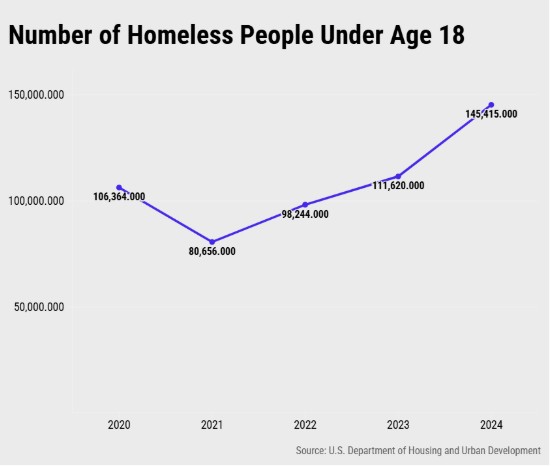$401,538
The Nebraska Department of Education (NDE) was granted an extension in October 2024 allowing additional time to spend down federal funds allocated during the COVID-19 pandemic, specifically those granted under the American Rescue Plan Elementary and Secondary School Emergency Relief – Homeless Children and Youth (ARP-HCY) program. Of the $3.5 million originally granted to Nebraska under APR-HCY, the extension allowed NDE until March 2026 to spend down the remaining $673,109. As of March 5, 2025, $401,538 remained according to U.S. Department of Education documents obtained by education news outlet The 74. However, a March 28 letter to each state from Department of Education Secretary Linda McMahon abruptly reversed the extension decision and informed states that the funds were unavailable effective immediately. This comes when homelessness among families with children under 18 has experienced a sharp increase in the last year, ballooning by 39%.

According to NDE, in the 2021-2022 school year Nebraska districts reported over 4,000 children or youth experiencing homelessness. These students were enrolled in 49 districts across the state, reporting anywhere from 1 to over 950 children or youth experiencing homelessness sometime during the year.
$6 billion
As Congress considers significant reductions in Medicaid spending, per capita caps are the favored proposal of Rep. Brett Guthrie, Chair of the House Energy and Commerce Committee. The committee is charged with finding $880 billion in cuts over the next 10 years, as outlined by a budget resolution passed in February, if the Senate agrees to align with the House’s approach to setting the federal FY2026 budget. Currently, the federal government pays a percentage of actual incurred Medicaid costs, which provides predictability for states. The federal cost share percentage varies based on enrollment group, but in Nebraska ranges from 58% for those qualifying under traditional Medicaid enrollment and 90% for those enrolled under Medicaid expansion. Under a per capita cap, the federal government would instead allocate a maximum amount per enrollee leaving states responsible for all additional costs. The Congressional Budget Office estimated based on 2022 data that a per capita cap would save the federal government between $579 billion and $871 billion over nine years, depending on the annual rate at which federal funding would be permitted to grow under the cap.
An Urban Institute analysis, modeled after the American Health Care Act, a previous consideration of per capita caps, indicates that Nebraska would lose $6 billion in Medicaid funding from the federal government. This would reflect a nearly 14% reduction in federal investments in the program. If the state of Nebraska were not able to make up that $6 billion difference, the state’s Medicaid program could face cuts to reimbursement rates, reductions in coverage, or enrollment limitations.
736,000
Nebraska biologists counted 736,000 sandhill cranes on March 17, which marked the 5th week of the annual migration. The Crane Trust, a nonprofit organization that provides tours and advocates for preservation of sandhill crane habitats, estimates that they may have even undercounted by up to 55,000 birds, who tend to congregate near bodies of water, making the Platte River Valley in central Nebraska an ideal stopover each year. Biologists anticipate that to have been the peak, as numbers continue decreasing as the cranes take advantage of favorable wind conditions. Each crane typically spends about a month in the state, according to Nebraska Game and Parks, devouring 1,600 tons of corn during their stay. This helps local farmers, as any leftover grain would become volunteer corn in next year’s crop. Thankfully, absent from the flock this year was evidence of H5N1, a highly contagious bird flu variant that has had biologists worried after it claimed 1,500 cranes in Indiana earlier this year. Nebraska’s visiting cranes showed no signs of the disease.
In 2017, the University of Nebraska at Kearney conducted an analysis of the economic impact of the crane migration, which brings nature lovers to the 13-county area of central Nebraska to view one of the world’s largest annual migrations. They found the majority (38%) of visitors came from other counties in Nebraska. The top six states in which crane visitors (30%) came from are: Colorado, Iowa, Minnesota, Wisconsin, Illinois, and Kansas. The remaining visitors (26%) came from other states in the U.S. and foreign countries. They estimate that the impact of the crane migration and resulting tourism was $14.3 million, generating 182 full-time jobs and $379,000 per year in property, sales and lodging tax revenue across the region.


